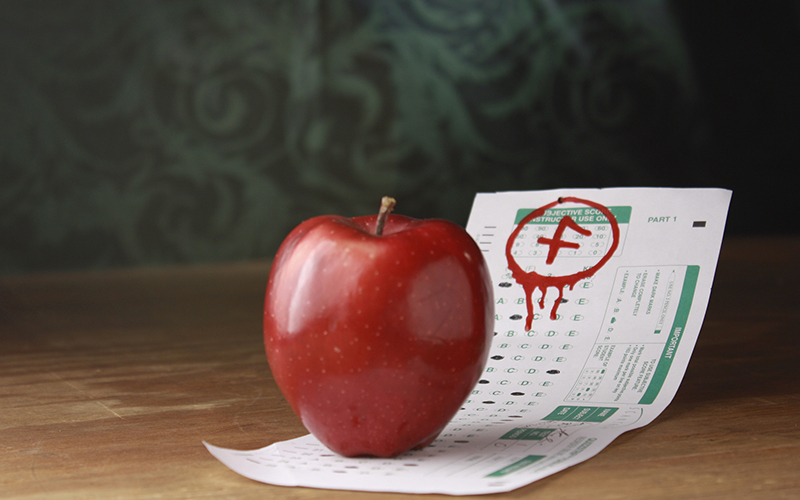
Arizona teachers who were asked by the Public Insight Network why they think the state has trouble finding and keeping teachers responded with a flood of unhappy, sometimes irate answers. (Photo by Naive Photography/Creative Commons)
WASHINGTON – For the past decade, the vast majority of Arizona counties have faced a teacher shortage at the beginning of the school year, and as school districts head into the summer many teachers expect more of the same.
And they’re not surprised.
A Public Insight Network query asking the state’s schoolteachers why they think Arizona cannot attract or keep teachers brought an outpouring of responses and one thing quickly became very clear: The Arizona teachers who responded to the query are not happy.
In more than 160 responses to the seven-question, short-answer query for Cronkite News, teachers complained about being overworked, over-evaluated and undercompensated. They felt underappreciated by parents and legislators and run roughshod over by administrators who they feel are underqualified and ill-equipped.
Joe Thomas, the president of Arizona Education Association, said the responses look a lot like responses AEA has collected from members in surveys it has done in the past.
“It’s an accurate understanding of the current reality of public school teachers,” Thomas said of the PIN responses.
The query was published on Cronkite News’ website and then shared on the Arizona Education Association’s Facebook page.
Some responses featured expletives, others were written in all capital letters and littered with exclamation points. Several respondents wrote pages worth of statistical explanations for their discontent, and others outlined very personal issues they had with their districts, schools, colleagues or students.
Cronkite News reached out to at least half of the educators who completed the query, but many were unwilling to talk to a reporter on the record. Others who were contacted had used a fake name on the questionnaire. Almost all said that they feared losing their jobs if they said anything negative about their school or district.
Editor’s note:
A previous version of this story misstated the number of teacher vacancies in the state. Arizona Education Association President Joe Thomas says there are 50,000 to 55,000 total teaching positions in the state. The story here has been corrected, but clients who used an earlier version are asked to run the correction found here.
A significant number of teachers did think there was disconnect between administrators and teaching staff – and respondents said it was negatively impacting their work environments and students.
Some longtime educators said that while student behavior is growing increasingly worse, parents’ and administrators’ willingness to support school policies is simultaneously decreasing.
Some wrote that as state standards have become stricter, they have lost control of their teaching style. Others said they feel like teachers spend too much time following administrative protocol that takes away from their classroom preparation, and often has them working out-of-contract hours.
“They are running schools like a business and not a place of learning,” said Kirk Hinsey, an educator of 31 years, in his PIN response.
They feel that their workload and classroom sizes continue to grow – but their compensation does not. According to the Arizona Department of Education, the average teacher salary in January 2016 was less than $40,000.
Salaries vary from district to district, but many teachers reported salary freezes and no sense that they will advance on the career ladder, or pay scale, regardless of their experience.
The most resounding sentiment was that teachers are doing too much to be paid as little as they make.
A spokesman for Superintendent Diane Douglas said that is a concern for the Arizona Department of Education, which is working to make teaching a more reasonable profession.
“Right now the best way to get more teachers in the classroom is to pay them … if you pay them, they will teach,” Stefan Swiat said.
But some teachers noted more emotional reasons for the shortage and their own discontent. Matthew Lentz has been an educator for 23 years, and he said the state government is responsible for the teacher shortage.
“There is a shortage because there is a mentality of the state government to discredit, demoralize, and de-fund public education,” Lentz said in his response.
Many respondents said they consider new state education legislation, like Proposition 123 and voucher program expansion, to be a slap in the face. Prop 123, approved narrowly by voters last year, would dedicate $3.5 billion to education over 10 years, but it leaves it to local schools to decide how to spend the money, which critics say will still leave Arizona trailing most states.
Melissa Girmsheid said in her response that every time legislative decisions regarding education are made without teachers, “it chips away at the professionalism of the teacher profession in Arizona.”
The AEA’s Thomas said qualified teachers exist – they just have no interest in working in Arizona schools in their current state.
Thomas said that Arizona has more than 90,000 active teacher certifications, and just 50,000 to 55,000 teaching positions at any one time. While some of those certifications belong to administrators, or to people who earned online degrees while living in another state, there is not actually a “teacher shortage,” he said, but the disrespect, low pay and lack of support lead to vacancies in the classroom.
Misty Arthur, director of the Arizona Federation of Teachers, did not respond to the query but offered many of the same concerns in a telephone interview. She said she does not anticipate the teacher shortage to improve this fall because administrators are under-qualified and ill-equipped.
“Teachers are not feeling supported administratively in the classroom,” Arthur said. “They’re losing control, so they’re leaving the classroom.”
EDITOR’S NOTE: Sources in the Public Insight Network informed the reporting in this story through a partnership with the Cronkite PIN Bureau. To send us a story idea or to learn more about PIN, click here.